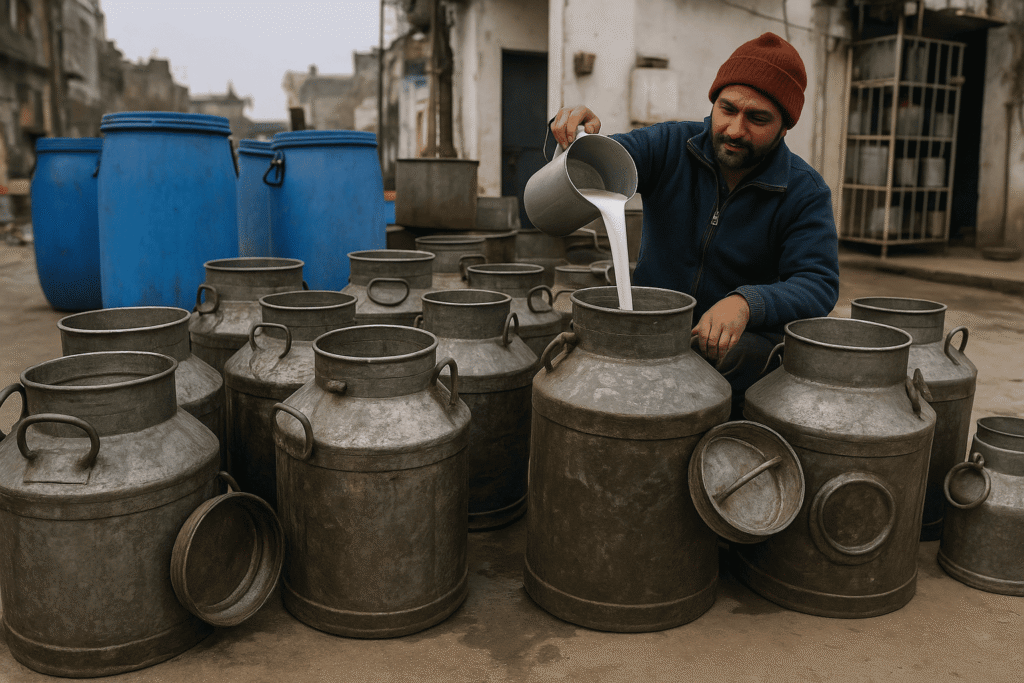Veganism
Ovo-Lacto Vegetarian
Same as VEGAN, but also eats eggs and milk products. This is the most ‘popular’ form of vegetarianism in many Western countries. It is not accepted by Food for Life.
Lacto Vegetarian**
Same as VEGAN, abstains from the consumption of meat as well as eggs while still consuming dairy products such as milk, cheese, yogurt, butter, ghee, cream, and kefir.
Vegan***
Does not eat animal flesh (meat, poultry, fish or seafood), animal products (eggs and dairy), and honey and does not wear or use any animal products (leather, silk, wool, lanolin, gelatin, etc.,). Some vegans also refuse to eat yeast products.
**Food Yoga International, formerly known as Food for Life Global, does not financially support affiliate projects that serve lacto-vegetarian meals. Grants are only awarded to affiliate projects that are exclusively vegan.
***Food Yoga International affiliate projects do not serve meals containing onion and garlic.
go vegan
What is Veganism?
- Thomas Kempis

A vegan is someone who does not consume animal products. While vegetarians avoid flesh foods, vegans also reject the exploitation and abuse inherent in the making of dairy and egg products, as well as in clothing from animal sources.
Here are some of the items vegans avoid: meat, milk, cheese, eggs, honey, fur, leather, wool, down, and cosmetics and chemical products tested on animals.
While leading a purely vegan life may be difficult for many, those who strive towards this goal can consider themselves to be practicing vegans.
Living vegan provides numerous benefits: to animals and the quality of their lives; to the ecological integrity of our environment; and to ourselves, by protecting our bodies from the dietary problems associated with consumption of animal products. Veganism is an integral component of a cruelty-free lifestyle.

its natural & Healthy
Why Vegan?
Veganism, the natural extension of vegetarianism, is an integral component of a cruelty-free lifestyle. Living vegan provides numerous benefits: to animals and the quality of their lives, to the ecological integrity of our environment, and to ourselves, by protecting our bodies from the dietary problems associated with consumption of animal products.
“One of the largest outbreaks of salmonella poisoning ever recorded in the United States came from tainted milk. “


What’s wrong with commercial dairy products?
Dairy cows are made pregnant yearly to ensure they produce adequate milk. In nature, the calf would suckle for almost a year but nature, like the calf, is denied by the dairy industry. Some calves may be separated from their dams on the first day of life; others might remain for just a few days. But as the inevitable by-products of relentless milk production each will have to endure one of several possible fates.
The least healthy bobby calves will be sent to market to be slaughtered for pet food; to provide veal for veal & ham pies; or for rennet to be extracted from their stomachs for cheesemaking. Some females will be reared on milk substitutes to become dairy herd replacements and begin, at 18-24 months of age, the cycle of continual pregnancies. Some will be sold at the market at 1-2 weeks of age for rearing as beef in fattening pens and slaughtered after 11 months, often without sight of pasture. Up to 80% of the beef produced in the UK is a by-product of the dairy industry.
Over 170,000 calves die in the UK each year before they are three months old, due largely to neglectful husbandry and appalling treatment at markets. A few will be selected for rearing as bulls, spending their lives in solitary confinement serving canvas ‘cows’ and rubber tubes. Artificial insemination is now responsible for 65-75% of all conceptions in the dairy herd.
In the US the vast majority of unwanted calves are reared for veal, all but around 12% of them spending their short miserable lives in narrow crates (5’x2′) on wooden slats and without straw. Whilst none suffer such a fate in Britain they are now exported for the purpose. In solitary confinement, unable to turn around or groom themselves they must drink the only diet they are allowed – a milk substitute gruel. Deliberately kept short of the iron and fiber which would redden their fashionably white flesh, they will suffer from sub-clinical anemia and gnaw at the crates and their own hair for the roughage they crave. Fed large doses of hormones and antibiotics to promote growth and prevent the onset of infections caused by the stress of confinement and malnutrition, they will suffer scours, pneumonia, diarrhea, vitamin deficiency, ringworm, ulcers or septicemia. After 14 weeks, barely able to walk, they are taken over long distances to slaughter.
In 1905, the Lord Mayor’s Cup at the London Dairy Show was won by a 24-year-old cow. Today it is impossible to find a dairy cow of that age. The cow is usually sent for slaughter at five to six years, less than one-quarter of their expected lifespan. Ketosis, laminitis, rumen acidosis, bse, mastitis, milk fever, staggers, liver fluke, lungworm and pneumonia are just some of the diseases facing the short life of the dairy cow.
“Sixty percent of America’s dairy cows have bovine leukemia and AIDS!”
Facts
Commercial Milk
Contaminants
Milk is frequently contaminated with antibiotics and excess vitamin D. In one study of 42 milk samples tested, only 12 percent were within the expected range of vitamin D content. Of ten samples of infant formula, seven had more than twice the vitamin D content reported on the label, and one had more than four times the label amount.
Lactose
Three out of four people from around the world, including an estimated 25 percent of individuals in the United States, are unable to digest the milk sugar lactose, which then causes diarrhea and gas. The lactose sugar, when it is digested, releases galactose, a simple sugar that is linked to ovarian cancer and cataracts.
Iron-Deficiency
Milk is very low in iron. To get the U.S. Recommended Dietary Allowance of 11 milligrams of iron, an infant would have to drink more than 22 quarts of milk each day. Milk also causes blood loss from the intestinal tract, depleting the body’s iron.
Diabetes
In a study of 142 children with diabetes, 100 percent had high levels of an antibody to a cow’s milk protein. It is believed that these antibodies may destroy the insulin-producing cells of the pancreas.
Calcium
Green vegetables, such as kale and broccoli, are better than milk as calcium sources.
Fat Content
Dairy products—other than skim varieties—are high in fat, as a percentage of total calories.
Allergies
Milk is one of the most common causes of food allergy. Often the symptoms are subtle and may not be attributed to milk for some time.
Colic
Milk proteins can cause colic, a digestive upset that bothers one in five infants. Milk-drinking mothers can also pass cow’s milk proteins to their breast-feeding infants.
Videos

Contaminated milk in India
“More than two-thirds of milk samples tested in a cross-country health survey in India were found to be contaminated with additives such as detergent and fertilizer,” stated a report by The National (1/11/12) newspaper. “Some samples also were found to contain more alarming substances such as detergent, the bleaching agent hydrogen peroxide and the fertilizer, urea. Also, the addition of water not only reduces the nutritional value of milk but contaminated water may also pose health risks.”
India is one of the world’s biggest producers of milk but struggles to meet domestic demand and so milk factories are getting desperate. Mr. Lahrry, a farmer from Bijnaur in the state of Uttar Pradesh said the milk being provided to the factories is good, but the contamination is likely taking place in the factories where the milk is being pasteurized. “[Because of] the greed of manufacturers, and because demand is so high, they don’t care about who drinks the milk and can add all these additives,” he said.

When I heard about this I thought, “If this is happening in India, the country where cows are revered, what was happening in commercial dairy factories in other countries where cows are disrespected?” Well, my fears were soon justified. Recently, Russian factory workers filmed themselves bathing naked in a huge vat of milk used to make cheese, stated the Daily Mail in the UK. “Yeah, our job is really boring,” says the caption on the online posting by Artem Romanov, 27, one of the workers at the Torgovii Dom-Siri cheese factory in Siberia. According to the comments posted by Romanov, the decision to take a bath in the milk was to celebrate a colleague’s birthday!

Commercial Milk Consumption and Prostate Cancer
By Neal D. Barnard, M.D. Abstract Prostate cancer is one of the most common malignancies worldwide, with an estimated 400,000 new cases diagnosed annually. Its incidence and mortality have been associated with milk or dairy product consumption in international and interregional correlational studies. As a result, case-control and cohort studies have further investigated this association and are described in this review. Of twelve case-control studies, six found significant associations, as did five of eleven cohort studies, with a relative risk of prostate cancer among those with the most frequent dairy product consumption ranging between 1.3 and 2.5, with evidence of a dose-response relationship. Mechanisms that may explain this association includes the deleterious effect of high-calcium foods on vitamin D balance, the tendency of frequent dairy intake to increase serum insulin-like growth factor-I (IGF-I) concentrations, and the effect of dairy products on testosterone concentration or activity. FULL REPORT

Food Yogi
We refer to someone that serves, eats and behaves in ways that respect all of the creation and help maintain the delicate balance of nature as a Food Yogi.
Food Yogi only uses fresh fruits, vegetables, beans, pulses, nuts, seeds and grains and foods considered to be pure in preparing meals.
The underlying idea here is that a Food Yogi lives by the principle of ahimsa (non-violence) in words, deeds and thoughts.


GET FOOD YOGA
Nourishing Body,
Mind & Soul
Click To Purchase Print Edition
Or Purchase (Kindle EDITION) only $3.15 (English) OR $2.39 (German)
*Prices above are in USD*
